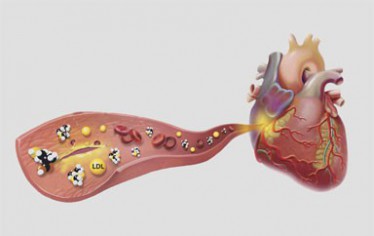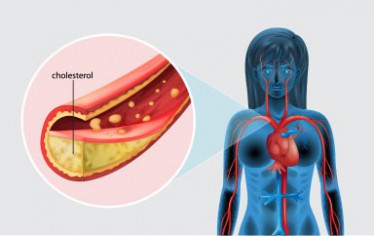Smokers' risk of developing CHD is 2-4 times that of nonsmokers. Cigarette smoking is a powerful independent risk factor for sudden cardiac death in patients with coronary heart disease. Cigarette smoking also acts with other risk factors to greatly increase the risk for coronary heart disease. People who smoke cigars, pipes and narghile seem to have a higher risk of death from coronary heart disease (and possibly stroke). Exposure to other people's smoke (second-hand smoking) increases the risk of heart disease even for nonsmokers.
As blood cholesterol rises, so does risk of coronary heart disease. When other risk factors (such as high blood pressure and tobacco smoke) are present, this risk increases even more. A person's cholesterol level is also affected by age, sex, heredity and diet. You can be thin and have high cholesterol! Here's the lowdown on where those numbers need to be:
• Total Cholesterol (TC): Less than 200 mg/dL
• LDL (bad) Cholesterol:
• If you're at low risk for heart disease: Less than 160 mg/dL• If you're at intermediate risk for heart disease: Less than 130 mg/dL• If you're at high risk for heart disease (including those with existing heart disease or diabetes): Less than 100mg/dL
• HDL (good) Cholesterol: 50 mg/dL or higher for women (High HDL defined as 60 mg/dL and above is considered protective against heart disease)
• Triglycerides (TG): Less than 150 mg/dL
High blood pressure is considered a silent killer (can be present with no signs and symptoms). It increases the heart's workload, causing the heart muscle to thicken and become stiffer. This stiffening of the heart muscle is not normal, and causes the heart not to work properly. High blood pressure also scars and damages your arteries and increases your risk of heart attack, stroke, kidney failure and congestive heart failure. When high blood pressure exists with obesity, smoking, high blood cholesterol levels or diabetes, the risk of heart attack or stroke increases several times.Here’s how the blood pressure numbers are evaluated:
• Normal: less than 120/80 mmHg
• Pre-hypertension: 120-139/80-89 mmHg
• Hypertension: 140+/90+ mmHg
• Hypertensive Crisis: 180+/110+ mmHg
Diabetes seriously increases your risk of developing cardiovascular disease. Even when glucose levels are under control, diabetes increases the risk of heart disease and stroke, but the risks are even greater if blood sugar is not well controlled. At least 65% of people with diabetes die of some form of heart or blood vessel disease. Persons who are obese or overweight should lose weight to keep blood sugar in control. You should always monitor your blood sugar level (fasting plasma glucose FPG) even if you do not have any symptoms. This test is usually done first thing in the morning, before breakfast and checks your fasting blood glucose levels. Fasting means after not having anything to eat or drink (except water) for at least 8 hours before the test. here’s a look at the numbers:
• Normal: FPG less than 100 mg/dL
• Impaired fasting glucose (or prediabetes): FPG 100 " 125 mg/dL
• Diabetes:
• FPG 126+ mg/dL (on 2 different occasions)• 2 hour plasma glucose after 75g oral glucose tolerance test OGTT > 200 mg/dL (on 2 different occasions) - the OGTT is a two-hour test that checks your blood glucose levels before and 2 hours after you drink a special sweet drink. It tells the doctor how your body processes glucose.• Random plasma glucose higher than 200 + symptoms (this test is a blood check at any time of the day if you have diabetic symptoms)• HBA1C > 6.5% (HBA1C measures your average blood glucose for the past 2 to 3 months)
That’s why it’s important to know your Body Mass Index (BMI), a numerical value of your weight in relation to your height (divide your weight in Kg by your height squared in meters). Here’s how it breaks down:
• Underweight: Less than 18.5• Healthy weight: Less than 25• Overweight: Between 25 and 29.9• Obese: 30 or higher
Moderate-intensity exercise for 30 minutes a day is highly recommended to prevent the risk of premature heart attacks.
Excess alcohol and salt consumption in conjunction with limited intake of fruits and vegetables increase the risk of heart disease. Drinking too much alcohol can raise blood pressure, cause heart failure and lead to stroke. It can contribute to high triglycerides, cancer and other diseases, and produce irregular heartbeats. It contributes to obesity, alcoholism, suicide and accidents. If you drink, limit your alcohol consumption to no more than one drink per day. Also, Choose nutrient-rich foods " which have vitamins, minerals, fibers and are lower in calories " over nutrient-poor foods. A diet rich in vegetables, fruits, whole-grain and high-fiber foods, fish, lean protein and fat-free or low-fat dairy products is the key.
The American Heart Association explains that chronic stress that causes an increase in heart rate and blood pressure may damage the artery walls. Doctors have used the term "Type A" personality or behavior to describe a person who is always in a hurry, impatient, often irritated, angry or hostile, and who strives for perfection. Studies found that Type A personality is associated with increased risk of heart disease. Some scientists have noted a relationship between coronary heart disease risk and stress in a person's life, their health behaviors and socioeconomic status. These factors may affect established risk factors. For example, people under stress may overeat, start smoking or smoke more than they otherwise would.
Smokers' risk of developing CHD is 2-4 times that of nonsmokers. Cigarette smoking is a powerful independent risk factor for sudden cardiac death in patients with coronary heart disease. Cigarette smoking also acts with other risk factors to greatly increase the risk for coronary heart disease. People who smoke cigars, pipes and narghile seem to have a higher risk of death from coronary heart disease (and possibly stroke). Exposure to other people's smoke (second-hand smoking) increases the risk of heart disease even for nonsmokers.
As blood cholesterol rises, so does risk of coronary heart disease. When other risk factors (such as high blood pressure and tobacco smoke) are present, this risk increases even more. A person's cholesterol level is also affected by age, sex, heredity and diet. You can be thin and have high cholesterol! Here's the lowdown on where those numbers need to be:
• Total Cholesterol (TC): Less than 200 mg/dL
• LDL (bad) Cholesterol:
• If you're at low risk for heart disease: Less than 160 mg/dL• If you're at intermediate risk for heart disease: Less than 130 mg/dL• If you're at high risk for heart disease (including those with existing heart disease or diabetes): Less than 100mg/dL
• HDL (good) Cholesterol: 50 mg/dL or higher for women (High HDL defined as 60 mg/dL and above is considered protective against heart disease)
• Triglycerides (TG): Less than 150 mg/dL
High blood pressure is considered a silent killer (can be present with no signs and symptoms). It increases the heart's workload, causing the heart muscle to thicken and become stiffer. This stiffening of the heart muscle is not normal, and causes the heart not to work properly. High blood pressure also scars and damages your arteries and increases your risk of heart attack, stroke, kidney failure and congestive heart failure. When high blood pressure exists with obesity, smoking, high blood cholesterol levels or diabetes, the risk of heart attack or stroke increases several times.Here’s how the blood pressure numbers are evaluated:
• Normal: less than 120/80 mmHg
• Pre-hypertension: 120-139/80-89 mmHg
• Hypertension: 140+/90+ mmHg
• Hypertensive Crisis: 180+/110+ mmHg
Diabetes seriously increases your risk of developing cardiovascular disease. Even when glucose levels are under control, diabetes increases the risk of heart disease and stroke, but the risks are even greater if blood sugar is not well controlled. At least 65% of people with diabetes die of some form of heart or blood vessel disease. Persons who are obese or overweight should lose weight to keep blood sugar in control. You should always monitor your blood sugar level (fasting plasma glucose FPG) even if you do not have any symptoms. This test is usually done first thing in the morning, before breakfast and checks your fasting blood glucose levels. Fasting means after not having anything to eat or drink (except water) for at least 8 hours before the test. here’s a look at the numbers:
• Normal: FPG less than 100 mg/dL
• Impaired fasting glucose (or prediabetes): FPG 100 " 125 mg/dL
• Diabetes:
• FPG 126+ mg/dL (on 2 different occasions)• 2 hour plasma glucose after 75g oral glucose tolerance test OGTT > 200 mg/dL (on 2 different occasions) - the OGTT is a two-hour test that checks your blood glucose levels before and 2 hours after you drink a special sweet drink. It tells the doctor how your body processes glucose.• Random plasma glucose higher than 200 + symptoms (this test is a blood check at any time of the day if you have diabetic symptoms)• HBA1C > 6.5% (HBA1C measures your average blood glucose for the past 2 to 3 months)
That’s why it’s important to know your Body Mass Index (BMI), a numerical value of your weight in relation to your height (divide your weight in Kg by your height squared in meters). Here’s how it breaks down:
• Underweight: Less than 18.5• Healthy weight: Less than 25• Overweight: Between 25 and 29.9• Obese: 30 or higher
Moderate-intensity exercise for 30 minutes a day is highly recommended to prevent the risk of premature heart attacks.
Excess alcohol and salt consumption in conjunction with limited intake of fruits and vegetables increase the risk of heart disease. Drinking too much alcohol can raise blood pressure, cause heart failure and lead to stroke. It can contribute to high triglycerides, cancer and other diseases, and produce irregular heartbeats. It contributes to obesity, alcoholism, suicide and accidents. If you drink, limit your alcohol consumption to no more than one drink per day. Also, Choose nutrient-rich foods " which have vitamins, minerals, fibers and are lower in calories " over nutrient-poor foods. A diet rich in vegetables, fruits, whole-grain and high-fiber foods, fish, lean protein and fat-free or low-fat dairy products is the key.
The American Heart Association explains that chronic stress that causes an increase in heart rate and blood pressure may damage the artery walls. Doctors have used the term "Type A" personality or behavior to describe a person who is always in a hurry, impatient, often irritated, angry or hostile, and who strives for perfection. Studies found that Type A personality is associated with increased risk of heart disease. Some scientists have noted a relationship between coronary heart disease risk and stress in a person's life, their health behaviors and socioeconomic status. These factors may affect established risk factors. For example, people under stress may overeat, start smoking or smoke more than they otherwise would.
Simply getting older increases your risk of damaged and narrowed arteries and weakened or thickened heart muscle, which contribute to heart disease. About 82% of people who die of coronary heart disease are 65 or older. At older ages, women who have heart attacks are more likely than men are to die from them within a few weeks.
• before age 55 for a first-degree male relative, such as your brother or father• before age 65 for a first-degree female relative, such as your mother or sister
• A normal homocysteine level is between 4.4 and 10.8 micromoles per liter (µmol/L)
• Low risk (less than 1.0 milligrams per liter, or mg/L)• Average risk (1.0 to 3.0 mg/L)• High risk (above 3.0 mg/L)
• A normal fibrinogen level is considered to be between 200 and 400 mg/L
Lipoprotein (a), or Lp(a), is a type of LDL cholesterol. Your Lp(a) level is determined by your genes and isn't generally affected by lifestyle.High levels of Lp(a) may be a sign of increased risk of heart disease, though it's not clear how much risk. Your doctor might order an Lp(a) test if you already have atherosclerosis or heart disease but appear to have otherwise normal cholesterol levels.Lp(a) is often tested if you have a family history of early-onset heart disease or sudden death. It should also be tested if your LDL cholesterol doesn't respond well to drug treatment.
Simply getting older increases your risk of damaged and narrowed arteries and weakened or thickened heart muscle, which contribute to heart disease. About 82% of people who die of coronary heart disease are 65 or older. At older ages, women who have heart attacks are more likely than men are to die from them within a few weeks.
• before age 55 for a first-degree male relative, such as your brother or father• before age 65 for a first-degree female relative, such as your mother or sister
• A normal homocysteine level is between 4.4 and 10.8 micromoles per liter (µmol/L)
• Low risk (less than 1.0 milligrams per liter, or mg/L)• Average risk (1.0 to 3.0 mg/L)• High risk (above 3.0 mg/L)
• A normal fibrinogen level is considered to be between 200 and 400 mg/L
Lipoprotein (a), or Lp(a), is a type of LDL cholesterol. Your Lp(a) level is determined by your genes and isn't generally affected by lifestyle.High levels of Lp(a) may be a sign of increased risk of heart disease, though it's not clear how much risk. Your doctor might order an Lp(a) test if you already have atherosclerosis or heart disease but appear to have otherwise normal cholesterol levels.Lp(a) is often tested if you have a family history of early-onset heart disease or sudden death. It should also be tested if your LDL cholesterol doesn't respond well to drug treatment.


















